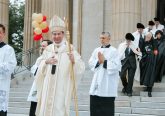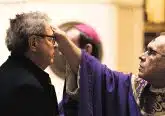Seasons’ Greetings and Christian Discernment
Each year we hear the perennial objections of those who lament hearing the salutation, “Season’s Greetings” instead of “Merry Christmas.” The common complaint, of course, is that this season is about the birth of the Christ, the savior of humankind. Thus, the reasoning goes, recourse to the general reference of “holiday season” is an embarrassed and compromised retreat from the real import of the holy day of Christmas, toward which the Advent season points. This lament is popularly phrased in the trope, “Let’s put Christ back in Christmas.”
I have sympathy for this demurral, especially when it reduces Christianity to a season of mawkish, treacly sentimentality— the verbal equivalent of a Thomas Kinkaid holiday painting. Similarly, if its motivation is to maximize the season’s commercialization, the objections are well-taken. However, we can glean something important by thinking about Advent/ Christmas as one of many seasons that make claims on our lives or express what those lives mean. Whether corporately through the shared liturgical calendar or individually through individual characteristics, we are “seasonal” people.
When we hear the word “calendar,” our default inclination is to think of the Gregorian calendar, introduced by Pope Gregory XIII in 1582 and represented by that thing hanging on our kitchen wall where we track dentist appointments, soccer practice, school plays, and dinner dates. It measures the seasons experienced by everyone in a particular geographic area, but does not account for the more meaningful ways we count the days of our lives. In fact, most of us order our lives by more than one calendar, because we observe more than one season—and the other “seasons” are usually more consequential.
For example, my life is ordered around at least three additional seasons. One is the season of immediate family events: children’s and grandchildren’s birthdays, wedding anniversaries, commemoration of deaths, and celebrations peculiar to my family. While these events obey the secular calendar, they are not defined by it. I order birthdays by my children’s chronological ages, not the calendar dates on which they fall. Similarly, tracking graduations and other milestones takes precedence over whether it is currently July or October.
The academic calendar’s seasons also order my life as I spend much time organizing my time by semesters and recesses. Whether it is Fall 2022 or Spring 2023 is often a more important consideration than the calendar month. Preparing course syllabi, compiling lecture notes, grading papers and enjoying mid-semester breaks are typically more consequential for my daily, weekly and monthly activities than whether the month is April or September.
Others can easily think of various seasons in their lives that are more compelling than the wall calendar’s chronology and vary by person and importance: baseball, ballet, planting and harvesting, hunting and other common endeavors. These life seasons are not incidental, but essential to how we see ourselves and relate to others. They remind us who we are.
A third season that orders my life and expresses who I am is the most important—I daresay it is the most important for this magazine’s readers. Measured by the liturgical calendar, it marks not just cycles of time, but eternity’s entrance into time. While the liturgical seasons do repeat themselves, the repetition is for the purpose of telling us that time—along with all calendars that measure it—points us toward the timelessness of eternal rest in God. More than any other, the liturgical calendar tells us both who we are and who we are called to be.
By the liturgical calendar’s seasons, from its New Year the first week of Advent to its culmination in the Feast of Christ the King, we do more than remember the events of Christian salvation, we enter into them. We do more than simply mark the days until Christmas; we embrace Advent as a time of hopeful anticipation. We do more than merely commemorate Christ’s birth; we stand before the prince of peace in adoration and gratitude. The liturgical calendar draws us into seasons of discernment and contemplation, by which we enter more deeply and authentically into the Good News of our salvation. We observe the liturgical year’s seasons so that we can experience redemption by Him who redeems time itself.
In his fascinating new book, How to Inhabit Time: Understanding the Past, Facing the Future, and Living Faithfully Now (Brazos Press), Christian philosopher James K. A. Smith proposes that this seasonality of Christian life compels us toward discernment. “More art than science,” suggests Smith, “discernment is an effort at orientation.” And he proposes that “one of the most significant exercises of discernment we can undertake across our lives is to grasp our seasonal location.”
This is why the liturgical calendar is so important in the Christian’s life. Unlike the one on the wall, the liturgical calendar reminds us of the seasons of creation, fall, anticipation and redemption. It reminds us “when” we are, to use Smith’s term, not just “who” we are. It is by discerning “when” we are that we can orient ourselves in the story that God wrote for us. That story’s seasons move us toward the salvation He intends for us. They greet us, and invite us to celebrate them as a people born in time but ordered toward eternity. Let us, then, offer “seasons’ greetings” to one another, as we discern our lives in Christ during this time between times.
 Dr. Kenneth Craycraft is an attorney and the James J. Gardner Family Chair of Moral Theology at Mount St. Mary’s Seminary & School of Theology.
Dr. Kenneth Craycraft is an attorney and the James J. Gardner Family Chair of Moral Theology at Mount St. Mary’s Seminary & School of Theology.
This article appeared in the December 2022 edition of The Catholic Telegraph Magazine. For your complimentary subscription, click here.













